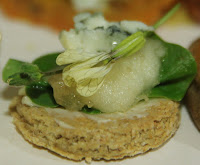There are so many descriptions in literature of famous cargoes, river barges and sail boats filled with gorgeous jewels and silks, gold and peacocks. Perhaps the most well known are Shakespeare's description of Cleopatra's meeting with Mark Antony on the Nile and the historic voyage of the Queen of Sheba or Saba to meet with King Solomon. Here I take my inspiration from both to create something that is fun and delicious for the festive buffet table.
I always like to use fruit in my salads but here is a Tunisian salad that uses only fruit and furthermore, two that are refreshingly light and juicy and a great foil to the other more substantial fare I've already uploaded to the groaning board.
And here's a poem that fits the food in its first and second stanzas! John Masefield's Cargoes:
'Quinquireme of Nineveh from distant Ophir,
Rowing home to haven in sunny Palestine,
With a cargo of ivory,
And apes and peacocks,
Sandalwood, cedarwood, and sweet white wine.
Stately Spanish galleon coming from the Isthmus,
Dipping through the Tropics by the palm-green shores,
With a cargo of diamonds,
Emeralds, amethysts,
Topazes, and cinnamon, and gold moidores.'
A FOREWORD ON BELGIUM ENDIVES
There are two ways of growing these with the familiar one being to regrow or rather to force the chicons indoors. It is usual to place the tap roots, with the tops cut off, in a free-draining pot or similar (I use an old stainless steel washing machine drum) and cover with a dark cloth or tarpaulin. This produces pristine white/gold, or if I use radicchio, beautiful red and white striped Belgium endive. However, the other way is to cut off the tap roots and replant outdoors and cover with a layer of soil and then a tarpaulin. Many people don't like this idea as endive de terre or earth chicory, as they are known here, are often sold in their natural rather more grubby state to differentiate them from the other kind. This is a shame because actually they are much sweeter than the indoor kind and as they are smaller, eminently suitable for use in the above recipe!
INGREDIENTS
FOR THE BARGES
(makes 20)20 Belgium endive leaves (2 - 3 chicons)
2 - 3 small oranges or mandarins
The seeds (and arils aka juicy outer seed casing) from 1 small pomegranate
10-15 pistachio nutsFOR THE VINAIGRETTE
2 dessert spoons of olive oil1 dessert spoon of balsamic vinegar
½ teaspoon raw cane sugar (rapadura)
½ teaspoon mixed spice
½ teaspoon turmeric
¼ teaspoon paprika
Extra spice for decorative sprinkling
METHOD
Place the leaves on a plate or serving dish.
Slice the peeled citrus fruits finely and cut each slice into half.
Place two halves in each of the 'barges'.
Add the pomegranate and the finely chopped pistachios to the cargo (reserving some of the latter for later).
Mix the ingredients of the vinaigrette together. Put a little of each in the barges.
Sprinkle the remaining spice and nuts over the whole dish and serve immediately. Otherwise keep chilled but add the sprinkle of spices just before you bring the dish to the table.
Enjoy!
All that needs to be said now is Bon Appėtit!
Hope to see you here again for another recipe from my 100 Gluten-Free Organic Party Foods Challenge!
All the best,
Sue
SOME MORE EXAMPLES OF OUR COLD SAVOURY APPETISERS
Radish Sail Boats Laden with Ricotta. Gluten-free
The fifteenth recipe in my 100 Gluten-free Party Food Challenge. Contrary to perceived wisdom, that picnics are a warm weather event, there is nothing...read moreMarinated Feta on Sticks - Gluten-free Cocktail Party
The tenth recipe in my 100 Gluten-free Party Food Challenge. The Feta I'm using is a classic Greek one with 30% goats'
and 70% ewes' milk...read more
Fresh Figs, Smoked Salmon Wraps. Gluten-free
The
twenty-second recipe in my 100 Gluten-free Party Food Challenge. For a
Winter party there is nothing more refreshing than a reminder of
Summer; sun-kissed figs...read more
Mini Scottish Oat Cakes with Roquefort Salad - Gluten-free
The sixth recipe in my 100 Gluten-free Party Food Challenge. As the oatcake recipe was handed down through families, it is difficult to know its exact origins...read more60's Cocktail Party Classic: Cheese, Ham & Pineapple Sticks
The
twentieth recipe in my 100 Gluten-free Party Food Challenge. A 60's
cocktail party classic, cheese and pineapple on a stick but this time
with marinated cheese...read more
RETURN TO MAIN CONTENTS PAGE
RETURN TO 100 GLUTEN-FREE PARTY RECIPES CONTENTS
© Sue Cross 2017
























